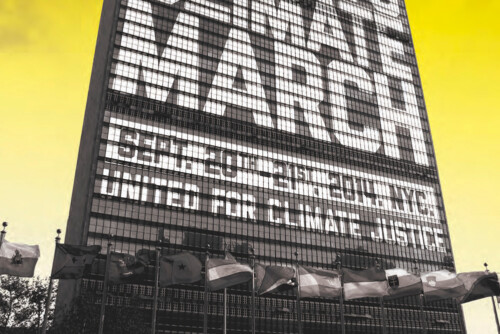The following comments are taken from a popular blog about New York City public schools and respond to an article posted about the closure of Brandeis and the opening of Upper West Success1 :
Why can’t this/these schools serve the community, which needs them, rather than bused-in children?
*
Why do they put a school for the worst kids in the city in an otherwise wonderful neighborhood. The tax payers of the UWS are already going to have to subsidize every aspect of these kids lives, from their single mother’s welfare checks, to their food stamps, to the public transportation that brings them to school, to their “education”, to their future incarceration, BUT we also have to tolerate them bringing their “thug-life” mindset to the stroller packed streets of the UWS….. Whatever they want to do, let them do it in their own neighborhoods.
*
I, for one, am not sad to see this school go. Let’s stop walking around the problem; the students, if you could even call them that, are the problem. Not the administration, not the new standards for school evaluation, and certainly not the teachers. These kids are leeches to society, they only cause harm….punk ass kids. You know exactly what kind of kids I’m talking about.
*
…. here on the Upper West Side, we have one sought-after high school… that can accommodate only a small fraction of our kids who apply, so they are also travelling around the city. Why not reopen Brandeis as a neighborhood high school? What am I missing?
*
… Get rid of the students who are the problem. Stop being so politically correct and careing for the students who disrupt the learning process. Get rid of the problem and schools won’t have to CLOSE.[sic]
These commentators not only position Brandeis students as problematic, but as the problem: as the cause for the failure of the school and its necessary closure. Moreover, according to the first commentator, Brandeis students not only harm the school, they harm society as a whole. Importantly, the commentators, who locate themselves as residents of the Upper West Side, position these depictions of Brandeis students against the community, or more specifically, their community.
These concepts of community and neighborhood are buoyed by a particular rhetoric of rights and choice that has come to be palpable on the Upper West Side in conversations about whom the district’s schools should serve and prioritize.2 Embedded within these discussions is a joined logic of the market and rights: of those who deserve their rights, and those who don’t. And, as evidenced by the example below, race and class contour the fault lines between the two.
On a January evening in 2011, the NYCDOE held (as required by law) a Joint Public Hearing about the opening of Upper West Success Academy.3 The hearing was held in the Brandeis building’s auditorium, and on their way down the stairs to the meeting, while waiting to add their names to the attendance and speakers’ lists, parents and community members commented on how well-kept the building was, and what a difference the recent building renovations had made; $22 million had just been put into the building to update it when the smaller high schools were opened. Close to 400 people were in attendance. Over 100 parents, teachers, students, and elected officials spoke both in favor of and against the charter school. As the hearing was called to order, Sheila, a middle-aged White woman, scurried in and looked for an empty seat. She found one near the front and sat down—and as she nestled in her seat, she talked about the reasons she had come out that night. Like most mothers, Sheila wanted a good school for her child. Upper West Success was important, she believed, because a school that served the community was needed. According to Sheila, too many “Brooklyn grandmothers” who didn’t even live in the area had gained access to the district’s schools.
Implied in Sheila’s comments are raced and classed based references to women—raising their children’s children—who are supposedly cheating the system by working hard to ensure that their children get a good education, sometimes by shuttling them back and forth for hours every day on long cross-borough journeys. In contrast to these imagined grandmothers is the notion that those who have chosen to move to the Upper West Side are thereby entitled to and deserving of a particular set of public goods and services.4 See, for example, the following quote from the Upper West Success Academy’s website, about the need for the school:
There are lots of high quality public schools on the Upper West Side. That’s why many of us chose this neighborhood in the first place and why so many new families continue to move in. The problem is: there are not enough of these great schools to meet current demand.5
Proprietary claims such as the one above position the problem, “there are not enough great schools to meet the current demand,” as one of supply shortage, not of structural inequality. According to this market-based logic, rights—even to public goods that are supposed to be universal, such as public education—are contingent upon choices that are predicated on economic wealth. As Stuart Hall explains, concepts of difference and choice have significantly guided the economic and political restructuring of recent decades. As such, the citizen consumer is confronted with a differentiation of public goods. This differentiation is accompanied by a growing inequality as well as a increased onus on the citizen consumer to make the right choice. As Hall notes, this structuring of public goods as market goods excepts the state from guaranteeing that all hospitals and schools, for example, are excellent.6 Such reasoning, as exemplified within the academic imaginary of Upper West Success, anticipates exclusion.
In the end, the combined forces of City, SCN, and the middle-class families won, and SCN was slated to open in the fall of 2011. But as Upper West Success Academy got ready to open its doors, a range of other issues needed to be addressed: How would a school that was built for high-school students physically accommodate kindergarteners? Woven into these debates about renovations that needed to be made to adjust the building to smaller students was the question of metal detectors—would kindergarteners really be expected to pass through these machines? Rather than remove the policing infrastructure from the school altogether, another solution was devised: a separate entrance so that Upper West Success Academy students would not be required to pass through the checkpoints that would continue to operate as usual for the “big kids” with whom the school was being shared.
Indeed, even as the students themselves disappear, the figures of Brandeis students remain. The fall of 2011 marked the entrance of the first group of Upper West Success students and the last group of Brandeis students. That same year, at a Community Education Council7 meeting held in a small room at the district’s offices on 93rd Street, a few parents—all of whom were White—chatted before the meeting began. They were discussing, with concern, a recent incident of violence that involved an older and a younger student. The first question asked was, “Was it Brandeis kids?” It was not, yet their figures, or perhaps the shadows of their Black and Brown bodies that represented a threat to these parents, loomed.
In many ways, Upper West Success is an exaggerated symptom of a much older problem: how some remain consistently forgotten while the futures of others continue to be well-secured. Yet the cultural logic that emerges in the postmortem period of the phase out of Brandeis and in the struggles that ensued over what would take its place elides this reality; and dispossession—propelled by a group of would-be concerned villagers claiming that this once-abandoned place should serve the community’s children—appears not only just, but also driven by concepts of community and neighborhood and a rhetoric of rights, and choice.
Conclusion
That Brandeis was going to be closed came as no surprise to many. The NYCDOE had been closing a number of schools throughout the city, most often with no consultation with school workers, students, or parents. After hearing the news that Brandeis would be closed, one school worker commented, “We’ve been waiting for the other shoe to drop for years.” However, part of the story that gets lost amidst the echoes that surround this seemingly inevitable “drop,” marked by the decision to close Brandeis, reveals the slow violence of education reform and illuminates a much longer trajectory of a decades-long project of abandonment that extends well beyond the city’s 2009 decision. Rob Nixon defines slow violence as:
. . . a violence that occurs gradually and out of sight, a violence of delayed destruction that is dispersed across time and space, an attritional violence that is not typically viewed as violence at all. Violence is customarily conceived as an event or action that is immediate in time, explosive and spectacular in space, and as erupting into instant sensational visibility. We need, I believe, to engage a different kind of violence, a violence that is neither spectacular nor instantaneous, but rather incremental and accretive, its calamitous repercussions playing out across a range of temporal scales.8
Stretching Nixon’s theory of environmental injustice to apply to public education, the city’s 2009 announcement of the closing can be considered a flashpoint and “newsworthy” event. Yet the slow violence that produced Brandeis remained relatively invisible, persistently active beneath the surface for decades. It worked through the state-driven reforms that have claimed to redress unequal learning conditions. This violence also worked in tandem with decades of state-sponsored urban renewal programs that silently (and sometimes not so silently) worked to displace long-term residents and produce what is now the Upper West Side of Manhattan, and create a situation in which Brandies students were out-of-place. And it continued through an emergent cultural logic that grounded the academic imaginary of Upper West Success.
For neighborhoods like the Upper West Side, schools are some of the few institutions through which low-income communities of color find each other in the wake of this multi-layered, slow, yet steady violence; and through which shared histories are still remembered and told. Before Upper West Success developers bid on space in the Brandeis building, they had first tried to obtain space at a nearby public elementary school that was not slated for closure but which, according to the NYCDOE, was under-utilized. The parents and teachers at this school organized quickly. They were able to fight back against the charter school co-location. Amidst the organizing meetings, several stories emerged: of teachers who had taught there for decades, of families who had been part of the school for at least three generations, and of school workers who had attended the school themselves. Like so many other schools, and also like Brandeis, this school was more than a building; it was a place that held these histories, of the daily acts of growing up, of working, and of the gendered labor of caretaking and raising children. Indeed, as one former New York City public school student reflected in a public meeting on education reform held in December 2010, “If they close the school, how are you supposed to go to your reunion?”
The question posed indicates what is at stake: a continued dispossession that threatens the capacity of a community to survive. The case of Brandeis and Upper West Success indicates a renewed forgetting and abandonment of a place and its people. We write through the postmortem lens of Brandeis’s phase out not to lament its closure. Rather, we hope that by chronicling how Brandeis went from being a long-forgotten place to one that was sought after, we might inform potential strategies that interrupt the variegated forms and speeds of violence that continue to circulate through public schools and the people who inhabit them.
- Phillsa Cramer, “Shrugs, sadness as Brandeis High School learns it will be closed.” Chalkbeat New York. February 3, 2009. [↩]
- Ujju Aggarwal, Edwin Mayorga, and Donna Nevel. “Slow Violence and Neoliberal Education Reform: Reflections on a School Closure,” Peace and Conflict: Journal of Peace Psychology 18.2 (2012): 156–164. [↩]
- While the Department of Education holds these hearings, thus complying with legal requirements, most often, the decisions that they are supposed to deliberate have already been determined by the time the hearings are held. Further, as Liza N. Pappas observes, “While the New York City Department of Education (NYCDOE) administrators have insisted that school closings will ensure better educational opportunities and outcomes, community activists, union leaders, elected officials, educators, and others dispute this contention. Nowhere are these debates more visible than at public hearings. In compliance with the reauthorization of the New York City mayoral control law, the NYCDOE convenes hearings for members of the public to provide comments on proposals that introduce ‘any significant change in school utilization’ including a closure, grade reconfiguration, resisting, or co-location of schools (i.e., two or more schools housed in the same building). Over the past 3 years, thousands of people have packed school auditoriums across NYC in overwhelming opposition to school closing proposals, but increasingly public hearings have become a site of contest between parents vying for excellent schools for their children.” Pappas, Liza N. “School Closings and Parent Engagement.” Peace and Conflict: Journal of Peace Psychology 18, no. 2 (2012): 165–72. [↩]
- While there is a rich discussion to be had about the articulation of raced and classed motherhood (about which mothers make the “right choices” for their children), for the purposes of this piece we limit our discussion to ways that race and class determine the processes of claim-making and asserting of rights that inform discussions about inequality and education reform. [↩]
- Success Charter Network, “Why the UWS?,” The Upper West Success Academy Charter School, October 17, 2011. [↩]
- Stuart Hall, “New Labour’s Double-Shuffle,” The Review of Education, Pedagogy and Cultural Studies 27.4 (2005): 319–335. [↩]
- Community Education Councils (CECs) are Community School Boards reconstituted through the re-centralization of the New York City public schools system. [↩]
- Rob Nixon, Slow Violence and the Environmentalism of the Poor (Cambridge, MA: Harvard University Press, 2011). [↩]




